
DIS Digital Conference System
SW 6000
Installation Manual
SW 6000 Conference Management Software
Version 6.2

DIS Digital Conference System
SW 6000
Installation Manual
SW 6000 Conference Management Software
Version 6.2

4.1???One PC??? Installation or first
4.2.1Preparations before installation...15
7.2Installing the CP 6001 Chip Card
7.6.1Command line parameters for the CUA 37
7.6.2Command line parameters for the CDA 38
7.7.1Command line parameters for the
8.2Upgrading procedure (using old
8.3Upgrading procedure, change of
8.3.1Upgrading from SQL 2005 Server
9.2.1Problems
9.2.2
10.2.1Connect string for the SQL Server 46
Installation Manual SW 6000 ver 6.2.docx

2 Introduction
This manual describes how to design a DCS 6000 Conference system using the SW 6000 Software Packages, how to install the SW 6000 Software Packages and how to setup the system for running the first time.
This document does however not describe the use of the applications like i.e. the CUA and CAA in details. Please consult the relevant manuals for this.
2.1Minimum Requirements
The minimum requirements for a PC running an application are:
???Min. Pentium 1.5GHz
???Min. 2 GB RAM
???Min. 10GB HD
???
???USB port if CP 6001 Chip Card Programmer is to be used
???TCP/IP network connection
???VGA screen. Please refer to the User Manuals for the SW 6000 applications for information on minimum resolution.
2.2Compatibility
The SW 6000 Software version 6.2.xx is only compatible with DCS 6000 Firmware Release 7.5.0 and higher.
If the DCS 6000 system is an earlier release, an upgrade of the system is needed. Please consult your DIS Partner for information about updating your system.
2.3Supported Operating Systems
SW 6000 Software v6.2 support standard installations* of the following operating systems
???Windows 7 (32 bit and 64 bit)
???Windows Server 2008,, 2008 R2 and 2012 R2
???WIN 8.1 x86 Enterprise/Professional/Standard
???WIN 8.1 x64 Enterprise/Professional/Standard
Important: Windows XP operating system is NOT supported
*Please notice that cloned operating systems are not considered a standard installation. Clones may cause problems with duplicate SIDs causing the MSDTC to fail. Clones should therefore be used with caution and only by experienced IT people.
2.4SW 6000
The SW 6000 Software, Prerequisites and User Manuals are available on www.dis.cc after login in as a Partner.
2.5User Manuals
The use of the applications is found in the following manuals:
???User manual CAA Conference Administration Application
???User manual CUA Conference User Application
???User manual CDA Conference Display Application
???User manual ECU External Control Application

3 System design
Prior to installing the software the system has to be designed, as the SW 6000 Software Package gives options for all
3.1.1Applications
The SW 6000 Software Packages consists of 4 main applications
???CUA - Conference User Application
???CAA - Conference Administrator Application
???CDA ??? Conference Display Application
???ECA - External Control Application
and the interface application for establishing the connection to the CU 6005/6011/6105/6110:
???CUI ??? CU Interface
An application for backing up data and restore data is also part of the package:
???SW6000 Backup Utility
The conference data (Delegate names, Conference names etc.) is stored in one of the following database installations:
???SQL - Microsoft SQL 2005 server Express
???SQL - Microsoft SQL 2008 server Express
???SQL - Microsoft SQL 2000 server, Enterprise Edition or Standard Edition
???SQL - Microsoft SQL 2005 server, Enterprise Edition or Standard Edition
???SQL - Microsoft SQL 2008 server, Enterprise Edition or Standard Edition
The SQL - Microsoft SQL 2008 server Express is delivered as part of the SW 6000 package
3.2Installation design
The CDA, CUI, CUA, CAA and ECA applications can all be installed on the same PC or all on separate PCs, but this is normal procedure.
For performance reason the CUI should be installed at the same PC/Server as the database.
Before installing the applications the design of the system has to be decided.
The following schematics are showing various system designs with SW 6000 applications. The abbreviations shown above are used in the schematics:
3.2.1One PC System Design
3.2.1.1Chairman or Technician control

Figure
3.2.2Installation with Multiple PC???s
3.2.2.1Chairman & multiple Delegates
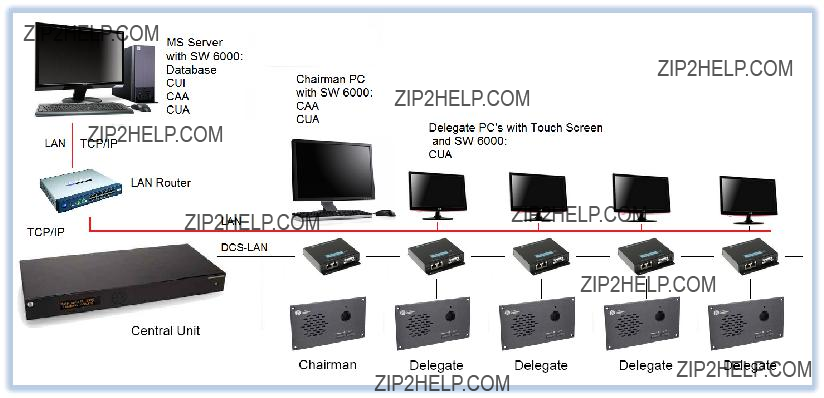
Figure

3.2.2.2Chairman & Technician control including Display and External control

3.2.2.3Chairman & Delegates control >10 PCs
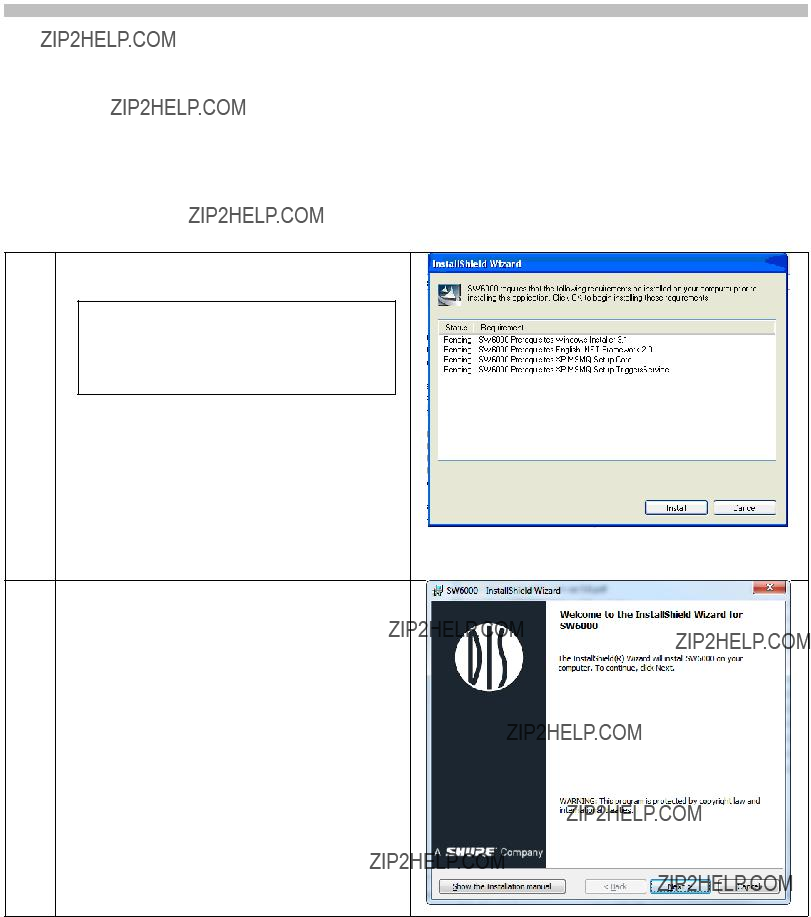
4 Software Installation
4.1???One PC??? Installation or first installation in a
The following installation procedure describes how to install the SW 6000 Software on a PC in a design as described in the section ???One PC System Design???.
Important: This installation is also recommended to use to install on the Server/PC, where the database is to be placed in a
4.1.1Installing SW 6000
1.Insert the CD with the ???SW 6000??? Software in the
Important: If the software is downloaded from the DIS web site the folder ???SW 6000 Installation??? must be copied to C:\ before the installation is started and the installation must be started from the copied folder (C:\SW 6000
Click on the Setup.exe in the ???SW 6000 #Installation??? folder on the CD.
???The install Shield Wizard??? will automatically show a list of ???Prerequisites??? required for running SW 6000.
Click ???Install??? for all required applications
2.After installing the ???Prerequisites???, the installation wizard continues by installing the SW 6000 Applications
Click ???Next???

3.Accept the License Conditions and click ???Next???
4.The installation gives two choices:
???One PC??? installation and ???Advanced Installation???.
Select ???One PC??? and click ???Next???
5.Select default language.
Important: The default language can only be selected during installation and cannot be changed after the installation is completed.
Click ???Next???
The ???CAA???, ???CUI???, ???CUA??? and ???SW 6000??? will then be installed.
The applications will

6.Click Install
7.If no SQL server is installed previously you will be asked to confirm if you want the SQL server 2008 Express to be installed.
Click ???Yes???
8.The SQL 2008 Server Express is now being installed.
9.The software is installed

10.Click ???Finish??? to complete the installation.
Shortcuts to the application have been created at the ???Desktop???, in the ???Start menu??? and in the ???Startup folder??? for automatic startup of the applications.
4.2???Advanced??? Installation (multiple PC???s)
The following installation procedure describes how to install the SW 6000 Software on multiple PC???s in designs as described in the section ???Installation with Multiple PC???s???.
4.2.1Preparations before installation
Before you start the installation of the SW 6000 Software Package you must ensure that the following preparations have been done:
???Ensure that you have LAN TCP/IP connection at the PC???s. Assign a permanent or automatic IP address
???If you use more than one PC in the system Windows 7/Server 2012 please note that there are some built in Windows errors, which have to be corrected before running SW 6000. See
???Install touch screen driver if using touch screen for the CUA
???Disable the firewall as default. If it is necessary to enable the firewall please follow the instructions in the sections ???4.2.3 Additional Firewall settings??? and ???4.2.4 Message Queuing settings???.
4.2.2Windows Corrections
If you use more than one PC in the system and are using Windows 7 or Server 2008/12 please note that there are some built in Windows errors, which have to be corrected before running SW 6000. The next sections show the corrections to be made
1.Enable MSDTC to allow the network transaction. To do this, follow these steps:
a.Click Start.
b.In the Search programs and files text box, type dcomcnfg.exe, and then click Enter.
c.In the Component Services window, expand Component Services, expand Computers, expand My Computer, and then expand Distributed Transaction Coordinator.
d.
Properties.
e.In the Local DTC Properties dialog box,
click on Security tab.
f.Click to select the Network DTC Access check box.
g.Under the Transaction Manager Communication group, click to select the Allow Inbound check box. To allow the distributed transaction to run on this computer from a remote computer.
h.Under the Transaction Manager Communication group, click to select the Allow Outbound check box. To allow the distributed transaction to run on a remote computer from this computer.
i.Under the Transaction Manager Communication group, click to select the
No Authentication Required option.
j.In the Local DTC Properties dialog box, click OK.
2 Configure Windows Firewall to include the MSDTC program as an exception. To do this, follow these steps:
a.Click Start.
b.In the Search programs and files text box, type Firewall.cpl, and then click Enter
c.In Windows Firewall dialog box, click
Allow a program or feature through Windows Firewall.
d.In the Allowed Programs dialog box, click
Allow another Program???. If button is not enabled then click Change Settings first
e.In the Add a Program dialog box, click the Browse button, and then locate the
Msdtc.exe file. By default, the file is stored inthe<Installation drive>:\Windows\System32 folder.
f.In the Add a Program dialog box, click
Add.
g.In the Allowed Programs dialog box, Select Microsoft Distributed Transaction Coordinator Service and check all check box???s
h.In the Allowed Programs dialog box, click
OK.

4.2.3Additional Firewall settings
If the system shall run with firewall active the following settings must be done on all PC???s in the system.
11.Open ???Control Panel\All Control Panel Items\Windows Firewall???.
Select ???Advanced Settings
12. Select ???Windows Firewall Properties???
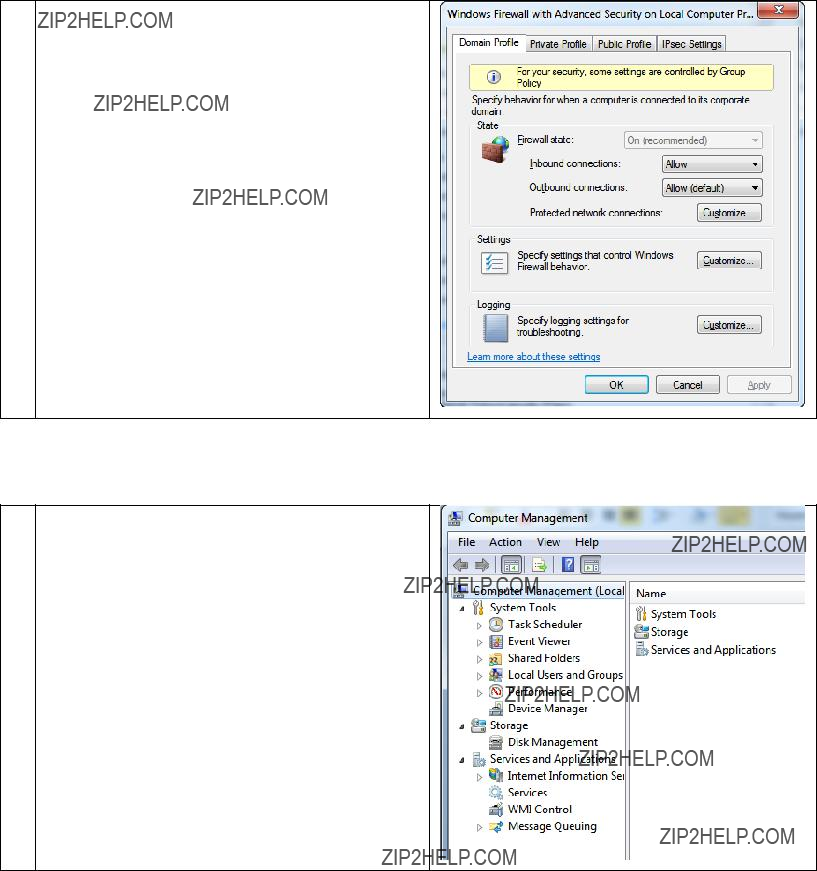
13.In??? Domain Profile??? and ???Private profile??? use the dropdown box to select ???Allow??? for Inbound connections???.
4.2.4Message Queuing settings
If the system shall run with firewall active the following setting must be done on all PC???s in the system.
14.Open ???Control Panel\All Control Panel Items\AdministrativeTools\Computer Management???.
Expand ???Services and Application??? and right click on ???Message Queuing??? and select ???Properties???.
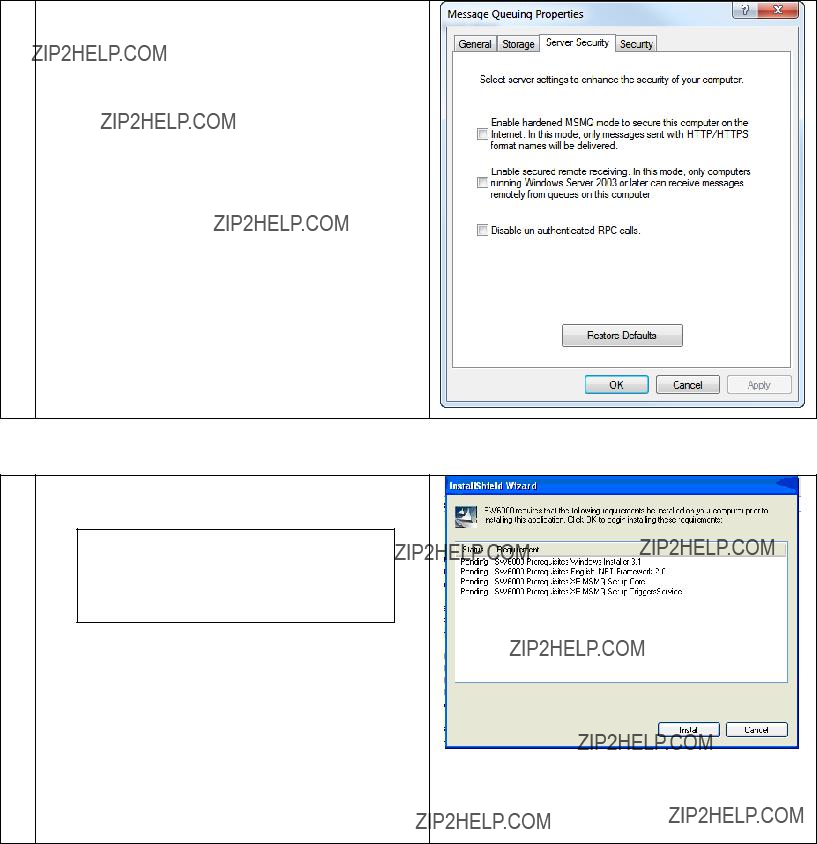
15.Select the tab ???Server Security??? and
4.2.5Installing SW 6000
16.Insert the CD with the ???SW 6000??? Software in the
Important: If the software is downloaded from the DIS web site the folder ???SW 6000 Installation??? must be copied to C:\ before the installation is started and the installation must be started from the copied folder (C:\SW 6000
Click on the Setup.exe in the ???SW 6000 #Installation??? folder on the CD.
???The install Shield Wizard??? will automatically show a list of ???Prerequisites??? required for running SW 6000
Click ???Install??? and continue clicking ???Install??? until you are asked if you want to install the SW 6000 Applications.

17.After installing the ???Prerequisites???, the setup program is preparing the InstallShield wizard.
18.After installing the ???Prerequisites???, the installation wizard continues by installing the SW 6000 Applications
Click ???Next???
19. Accept the License Conditions and click ???Next???
INFO: The ???SW 6000 Database??? option has to be
Select only the ???SW 6000 Database??? on a PC, where the ???SQL Server 2008??? has been installed

20.The installation gives two choices ???One PC??? installation and ???Advanced Installation???.
Select ???Advanced Installation??? and click ???Next???
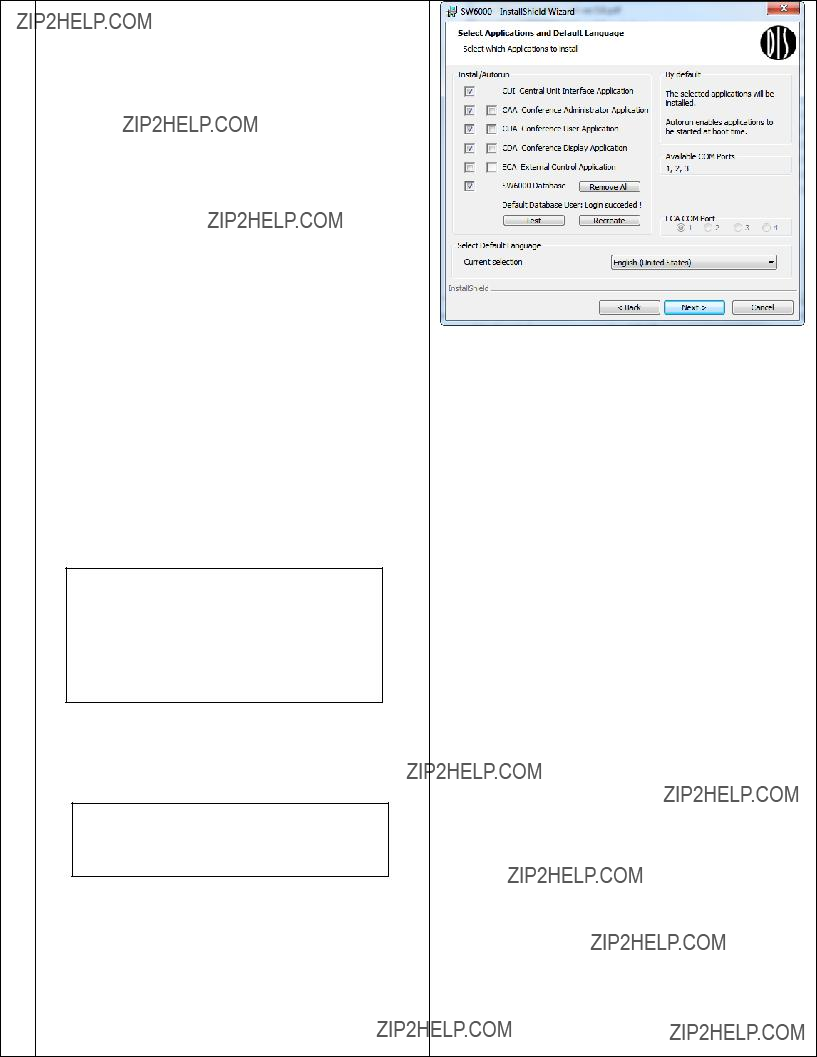
21.CUI
Select the CUI if you are installing on the PC where you previous has made a ???One PC??? installation or you are making a new installation on a PC, where the SW 6000 database shall be installed.
CAA, CUA and CDA
Select one or more of the following applications: CAA, CUA, CDA or ECA all depending on your system design.
ECA
Select the application ECA depending on your system design. Select the COM port, you want to use with the ECA.
SW 6000 Database
Select the SW 6000 Database if you want to add one or more additional databases to the
PC/Server where the SQL Server 2008??? has been installed or you are installing a PC/Server with a new database.
INFO: The ???SW 6000 Database??? option has to be
Select only the ???SW 6000 Database??? on a PC, where the ???SQL Server 2008??? has been installed
Select Default language
Select the default language only if you are making a new database installation
IMPORTANT: The default language can only be selected during installation and cannot be changed after the installation is completed
Autorun
Tick the applications, which has to
Click ???Next??? Click ???Next???

22.If ???SW 6000 Database??? was selected in the selection in previous screen the ???Database Settings??? will show.
Database Engine
The database server installed together with SW 6000 is MS SQL Express. Select ???MS SQL Server??? is this type of database server is in use.
Databases
Select ???SW
INFO: The SW 6000 system can handle up to 4 databases in each database engine. The names of the databases are limited to
For most installations only the
IMPORTANT: Remember the name of the database(s) selected as well as the name of the computer as this information is needed when installing the SW 6000 Software on other PC???s
Click ???Next???
23.Set Database Connection
This page sets the type of database connection string to be used.
Create SQL Server Express connection is default
Create SQL Server connection shall be selected if a ???MS SQL Server??? is in use.
Create Database Connection???s might be checked if the option to connect to multiple databases shall be configured. This setting can be done later in the CAA application.
Details on hall definition settings are present in the section ???7.4 Creating Database Connections???.
Click ???Next??? to continue.

24. Click ???Install??? to install the options selected
25.If you selected ???SW 6000 Database??? in item 16.
If no SQL server is installed previously you will be asked to confirm if you want the SQL server 2008 Express to be installed.
Click ???Yes???
26.The SQL 2008 Server Express is now being installed.
27. The SW 6000 Applications are then being installed

28. The database(s) are created
29.If a connection string is present, you will be asked if you want to modify the connection string.
Click No if you do not want to change
Click Yes if you want to modify the connection string or just want to check.
30.If no ???Connection String??? was present or you selected ???Yes??? to modify, the ???Test SQL Express database connection??? options are shown.
Info: The ???connection string??? is the ???address??? the application uses to connect to the database
Use default or change those fields if needed:
???Name of the computer where SQL Express is located??? Insert the name of the PC, where the database is installed.
In the example the name is
Important: When installing the applications CAA. CUA, ECA or CDA on other PCs than the one where the database is installed the ???Name of the computer?????? and ???Default database name??? has to be filled in. The name of the computer is the computer, where the SQL database server is installed.
???Default database name??? In the example the name is the default
Other settings are normally not changed.

31.Create, Test and Save Connection String:
Click the ???Create default ConnectionString??? button to generate the connection string according to the parameters provided.
The resulting ???ConnectionString??? will be displayed in the textbox at the bottom of the window
Click ???Test connection???.
The message ???Connection succeeded??? will show.
Important: This test must succeed. If the test does not succeed then the name of the computer or the default database name might be wrong.
Click ???Save ConnectionString???
Click ???Close???
32.Click ???Finish??? to complete the installation.
Shortcuts to the application have now been created at the ???Desktop???, the ???Start menu??? and in the ???Startup folder??? for automatic startup of the application.
33.If you have selected ???Create Database Connection???s??? previously, the ???Create Database Connection???s??? window will appear.
For details in how to setup database connections please refer to the section ???Error! Reference source not found. Error! Reference source not found.???.
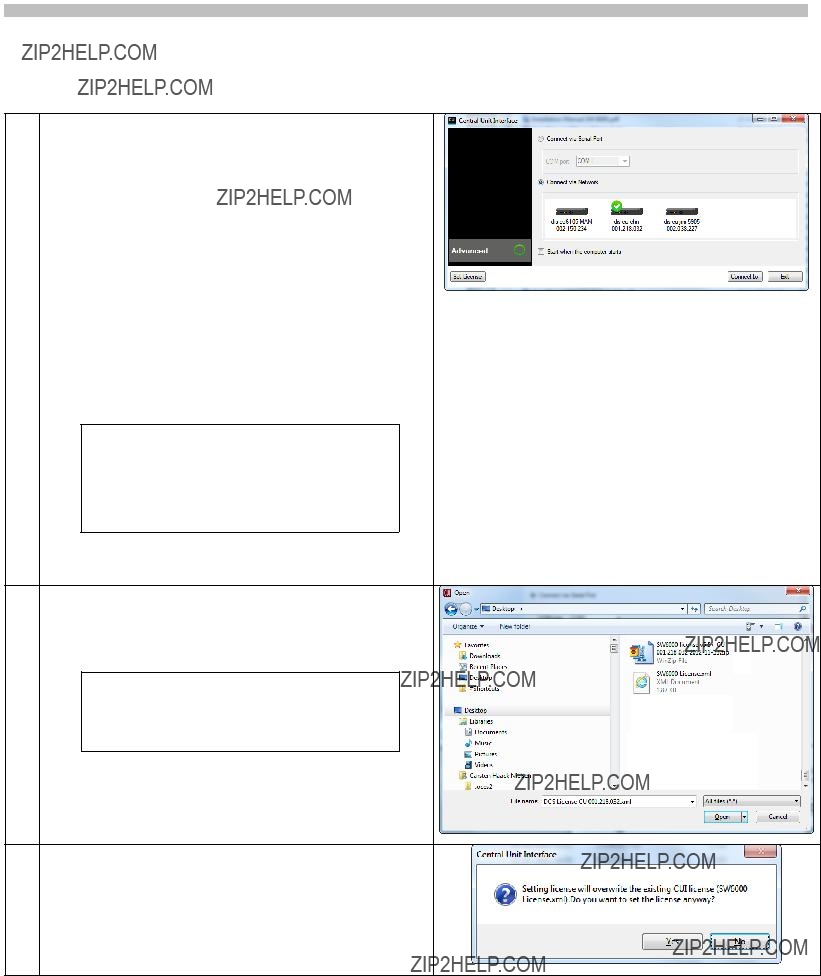
5 After installation of SW 6000 Software
5.1Starting the CUI for the first time
34.After the SW 6000 has been installed a shortcut to the CUI application have now been created at the ???Desktop???, in the ???Start menu??? and in the ???Startup folder??? for automatic startup of the application.
When starting the CUI for the first time the CUI configuration windows open.
Select..
Connect via Serial Port if your CU is a CU 6005, CU 6010 or CU 6011, by selecting the COM port, where the CU is connected.
Connect via Network if your CU is a CU 6105 or CU 6110, by selecting the appropriate CU in the list window.
Important: The list window will only list the CU???s if ???Apple ??? Bonjour for Windows??? is installed. If ???Bonjour is not installed please refer to point 39 in the section ???7.1 Advanced setting in the CUI??? and use the CU IP address to identify the CU.
35.Click ???Set License???
A browser window will open. Browse to the ???SW 6000 License??? file.
Info: For more information about the SW 6000
License file, please refer to section ???0
License file???.
32 Click ???Yes??? to insert the license file

36.Click ???Connect to???
The CUI will now start connecting to the selected CU.
Info: The selections made are used next time the CUI is started, where the ???CUI Configuration window??? will not open.
If a new selection has to be made, the shortcut ???Configure CUI??? in the Start menu must be used.
For ???Advanced??? option please refer to later section
37.When the CUI is started an Icon is visible in the taskbar.
For details please refer to ???Advanced options in later section.
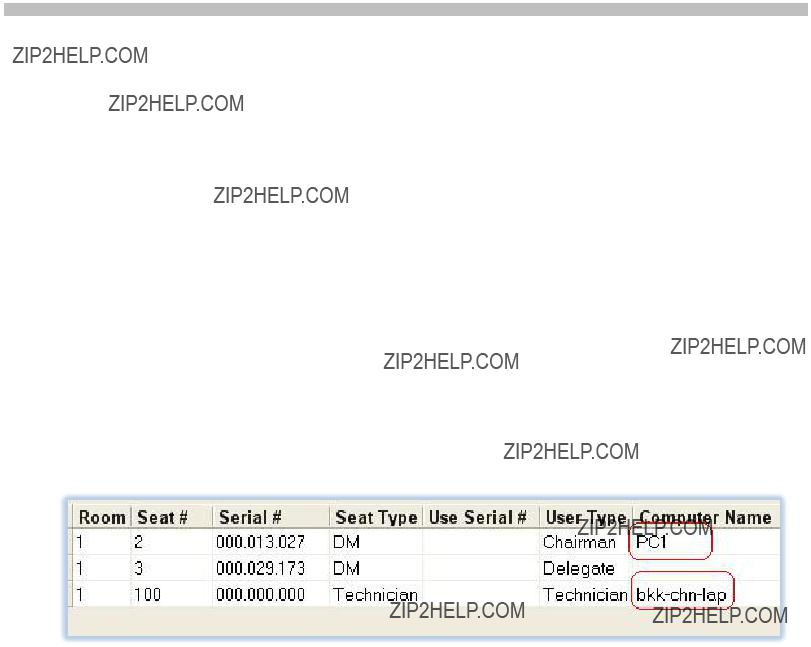
6 Getting started
The system has now been installed successfully.
The following sections describe the necessary steps to get started. However please refer to the CAA User Manual, the CUA User Manual and CDA User Manual for a throughout description of how to use the SW 6000 System.
6.1Steps
1.Connect the CU 6005 or CU6011 Central Unit to the PC, where the CUI is installed, with a RS232 cable or connect with TCP/IP if CU 6105 or CU 6110 are used.
2.Turn on the CU with all units (Delegate Units, Chairman Units, AO units etc.) connected.
3.Start the CU Interface Application (CUI).
If the CUI version is not compatible with the database you will be advised to start the CAA to automatically update the database. You will then have to restart the CUI.
When the CUI Application starts to communicate with the CU it will receive information for all units connected to the CU. The CUI Application will then create one seat in the Seat assignment table for each Chairman Unit and Delegate Unit, numbering the seats, starting at one and counting upwards.
Hint: To make is easier later to assign delegates to seats and to make Mimic diagrams the seats should be renumbered to give a more logical order.
Figure
4.Start the Conference Administration Application (CAA). If needed the Database will be upgraded automatically.
Assign computer names for each of the seats where there is a PC on the network that will run the Conference User Application (CUA).
6.Select the Mimic screen from the ???Setup/Configuration/Mimic Configuration??? and create a new Mimic diagram.
Creating a Mimic diagram requires the user to import a bitmap showing the room or hall as a background image and then to import all seats onto the Mimic
diagram and position the coloured dots representing a microphone or seat.
7.Select the User Type screen from the ???Setup/User Type??? and create additional user types (e.g. Vice Chairman) to be used when creating the list of Delegates and to be used as defaults for the seats when no one is logged in. The user types that are created during installation can either be modified or deleted (the Chairman and Delegate user type can be modified but not deleted).
The User Type determines individual microphone settings, screens, buttons and functions that will be available when a user is logging into the CUA.
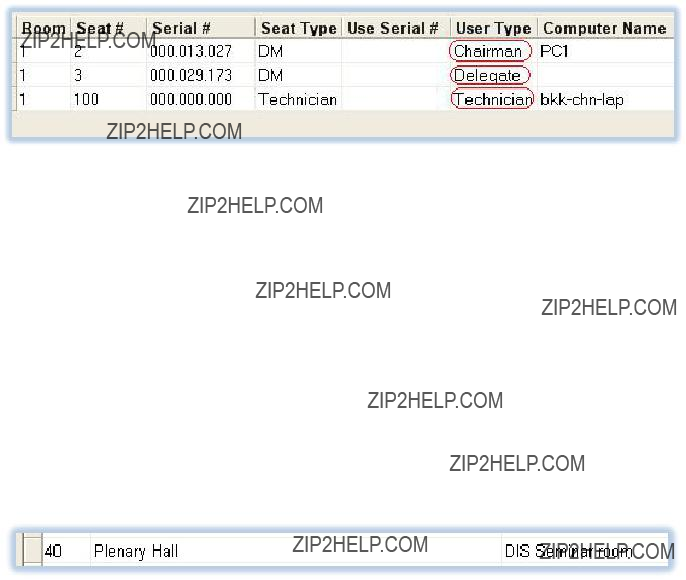
A User Type is also associated with each seat to determine the settings that must apply as default when no one is logged in.
and assign a user type to each of the seats to be used as a default when no one is logged in.
Figure
9.Select the ???Delegates??? screen and type in information for the various users of the system.
It is possible to enter any additional information required for delegates in up to four customisable fields.
10.Selectthe ???Setup/Configuration/Delegate List Configuration??? and configure the width of the various fields on the delegate lists.
11.Select the ???Setup/Language/Languages??? and create additional system languages if
needed (English is created during installation).
12.Select the ???Setup/Language/Labels??? to create translations for the languages that have been added. If some or all labels are not translated then the default language translation (English) for a particular label will be used.
13.Select the ???Setup/Language/Labels??? and chose the English tab and select label 40 and change ???Plenary Hall??? to a description, which applied for your installation
Figure
14.Select the ???Message??? screen and create messages.
15.Select ???Setup/Configurations/CDA Configuration and change (if needed) Font Size, Colours etc. for the various CDA screens available.
16.Select ???Conference???
17.Add a conference
18.Fill in a proper name for the conference.
19.If chip cards or login using code are not in use select ???Prepared Delegate List???.
20.Select the preferable ???Microphone Operation Mode??? and preferable ???Voting Parameters??? (both ???Microphone Operation Mode??? and ???Voting Parameters??? can be changed at any time during the conference???
21.Change Start and Stop date if needed.
22.Click update
23.Select ???Delegate List
24.Select the delegate who is to be placed in Seat 1 and click >>

Figure
25.Select the delegate who is to be placed in Seat 2 and click >>. Continue until delegates are placed in all seats
26.Click ???Hide???
Figure
27. Select for each Delegate the User Type, which shall apply for the delegate for this conference.
Figure
28.Click Update and close the Delegate List screen
29.Select Agenda and fill in an Agenda for the Conference
30.Select Options and select the default options for this conference
31. Click Update
Hint: If the conference created is supposed to be the default for future conferences then click ???Save as Default???
The system is now ready for use, however it is strongly recommended to read the User Manuals for Applications.

7 Advanced Settings
7.1Advanced setting in the CUI
38.When activating the shortcut ???Configure CUI??? in the Start menu the CUI interface opens.
When ???Advanced??? it ticked more configuration options in three tabs will be available.
CU Connection
Configuration Name Different CUI configurations can be made. If a configuration is Added, a shortcut is created on the desktop with the name of the configuration.
Hostname The hostname or IP address can be typed into this field to create a connection, where the CU is not turned on.
39.Database
CUI connections to different databases can be setup.
Click ???Add??? and give the new configuration a name and make the settings as needed. Click ???Update??? to save the new configuration.
Previous configurations can be changed by selecting the configuration in the top window, then making the changes and click ???Update???
40.Options
The following options are available:
???Start when the computer starts
???Show the CUI window at startup
???CUI creates log
A text field is available for additional options
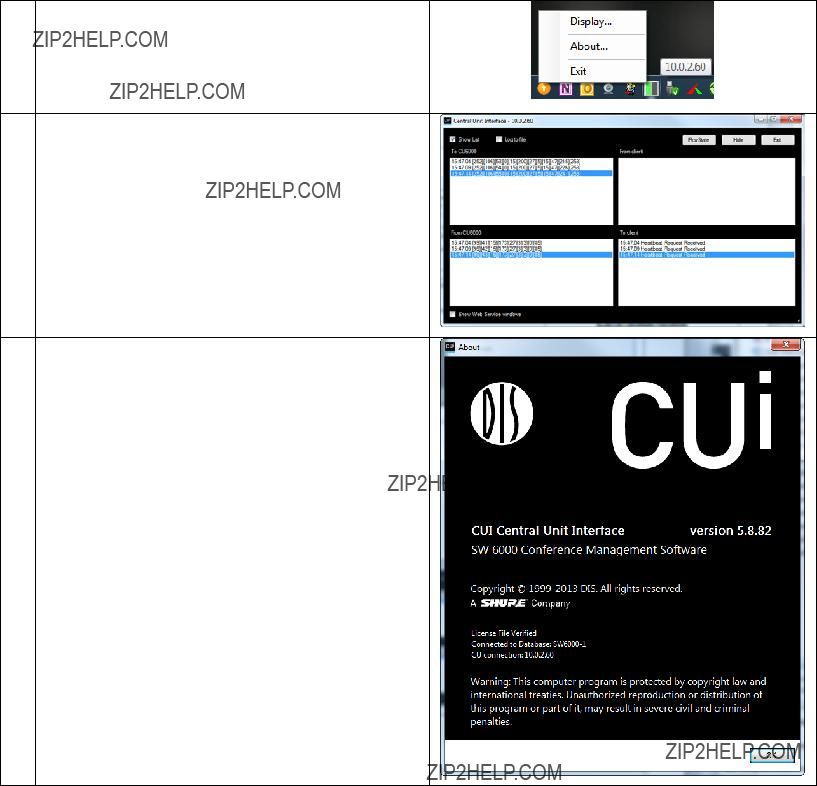
41.When the CUI is started an Icon is visible in the taskbar.
42.Display
Show messages to/from the central unit
43.About
Shows if the ???License File??? is verified and connection details
7.2Installing the CP 6001 Chip Card Programmer
The CP 6001 Chip Card programmer is used for programming and reading DIS chip cards. To install the programmer follow the instructions:
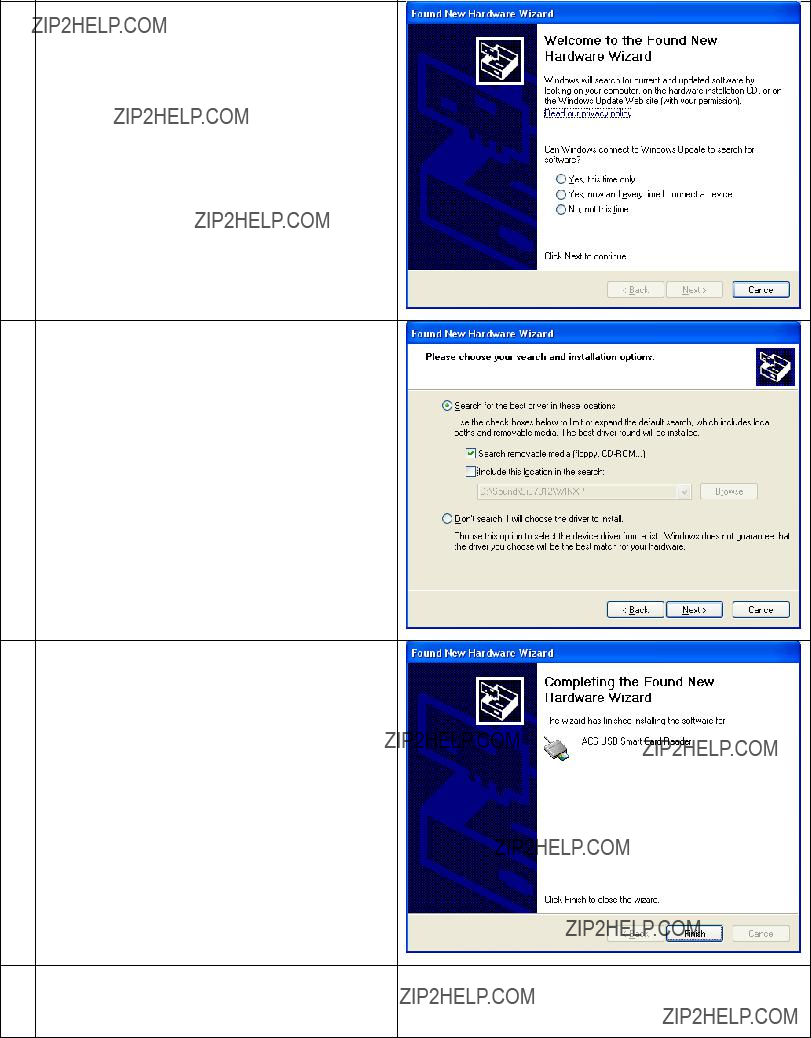
44.Connect the programmer to an available USB port on the PC, where a CAA application is installed.
Your windows operating system will automatically detect the CP 6001 by showing the ???Found New Hardware Wizard???.
Click ???No, not this time??? to continue.
45.Insert the SW 6000
Select ???Search removable media (floppy CD- ROM???)
Click ???Next???.
If the ???Windows Installer??? cannot find the driver, please proceed to step 5.
46.The driver has been installed and the CP 6001 Chip Card Programmer is now ready to use.
47.If the ???Windows Installer??? cannot find the driver, please click the ???Include the location in the search??? and click ???Browse???

48.Include the driver folder as shown (to be found in the SW6000
Select the folder ???ACR38U_inst_111108_P??? Click ???OK???.
49. Click ???Next???.
50.The driver has been installed and the CP 6001 Chip Card Programmer is now ready to use.

7.3Customer Logo
The DIS logo in the CUA application can be exchanged with a customer logo.
Do the following:
1Open the file "CUA logo background.bmp" with a
The file is found on the SW 6000
The image in the file has the same colour as the default background for the CUA application.
The image size is 214x162 pixels and the new logo must have the same image size.
7.4Creating Database Connections
If your CUA or CAA application on the PC shall have access to more databases you must check the checkbox ???Create Hall Definitions??? when prompted during installation of the CUA, CAA.
During the installation of SW 6000 software, if the ???Create Hall Definitions??? checkbox is selected, it is time to set the hall definitions, the following window will appear.
Figure
Inside the window there is a grid with 4
computer, where the CUI is installed (and database).
There are 6 buttons at the bottom of the window.
1.???Delete??? button will delete the current row in the grid.
2.???Save??? button will save all row present in the grid to Windows registry.
3.???Cancel??? button will cancel any changes made to the Database Connections.
4.???Close??? button will close the window.
5.Create ConnectionString??? button is used to create a ConnectionString for the current row on the grid. When this button is pressed, a new window ???Figure
a.Data Source Type - Select if the database is SQL Express or SQL.

DIS Digital Conference System
b.Name of the computer where SQL Server is installed - Insert the name of the Computer running the CUI and database
Figure
String
c.Default database instance name - The default value is SW6000
d.Default database name - The Database Name is the name of the database we wish to connect. The names are limited to
e.Default database time out - The default database timeout is the timeout value for the connection established
7.5License file
A licence file is needed for running the SW 6000 Software. Even if it might be possible to run functionality and/or application which are not licensed for, it is illegal in accordance with the License Conditions.
A licence file includes the serial number of the CU 6005, CU 6010, CU 6011, CU 6195 or CU 6110 and is delivered from DIS in a zipped format like this example ???SW6000 license v5.5 CU xxx.xxx.xxx
Before the license file can be used it must be un-
zipped. The name of the
User Manual
f.Database user - Default value used during installation of SW 6000
g.Database user password
i.When the selections has been made click ???Make ConnectionString???.to create the connection string. Use the ???Test Connection??? button to test the connection string.
ii.Close the window and proceed filling in information and create connection string for all the connections.
h.Click ???Make??? to generate the connection string.
i.???Test Connection??? button will validate the Connection String created
j.Click ???Close??? button to close the window.
???Test Connection??? button will validate whether the ???Connection String??? on the current row in the grid can be used to successfully connect to the database.
Note: The licence file ???SW6000 License.xml??? is located in the CUI execute directory (C:\Program Files\ DIS\CU Interface Application).
If no license file is found, the license file is invalid or the license is expired this will be displayed using a message box on the PC running the CUI interface and a system message will also be sent to CUA computers that have system message monitoring capabilities.
Important: Connection to the CU is needed for the license to be checked and hence the operation of said SW. If the CU is not connected and therefore the licence file is not checked the CAA can be started and access the Database info such as the seat table but all of the licensed features would be greyed out and unavailable.

7.6Advanced settings CUA, CDA
7.6.1Command line parameters for the CUA

7.6.2Command line parameters for the CDA
7.7Configuring the ECA
51.After the ECA has been installed, the ECA shortcut is placed on the Desktop and in the start folder.
52.Click the ???ECA Interface??? shortcut on the desktop
53.When starting the ???ECA??? the following window appears:
The COM ports, which are configured, will be highlighted.
Insert the Name of the Computer, where the database is installed
Insert the ???Default Database name??? Click ???Save???
7.7.1Command line parameters for the ECA

8 Upgrading from previous versions
8.1Upgrade
54.Backup the Database using ???SW 6000 Backup Utility???.
55.On each PC run the SW 6000 Installation and select Advanced Installation and select the Applications, which are installed (CUI, CUA, CAA, ECA and/or CDA) and have to be upgraded.
Do not select ???SW 6000 Database???.
Important: An installed database is never ???overwritten??? during an upgrade even if it is selected to be installed
56.If the CUI is started after an upgrade of the Software a message, that the database shall be upgraded might appear.
Click OK to close the message Close the CUI
57.Start the CAA
Accept to upgrade the database
Click OK to close the message and the CAA will start
Start the CUI
8.2Upgrading procedure (using old MSDE Database Server)
If you have a previous SW 6000 version already installed using the MSDE Database Server, you can upgrade as follows.
58.Backup the Database using ???SW 6000 Backup Utility???.
59.Remove the old installation using ???Control Panel - Add or Remove Programs??? in the following order:
SW 6000
MSDE Installation

60.Install the applications as explained in the section ???Software Installation???.
61.Restore the Database using ???SW 6000 Backup Utility???.
62.Start the CAA.
You will be prompted to upgrade the database when the CAA is started the first time after the installation. Accept this and the database will automatically be upgraded.
Click ???Yes???
63.The upgrade is now completed. Click ???OK???.
64.Insert a new SW 6000 License file as explained in the section ???License File???
65.Update other PCs in the system however do not install the SQL Server 2008 Express
Edition & SW 6000 database
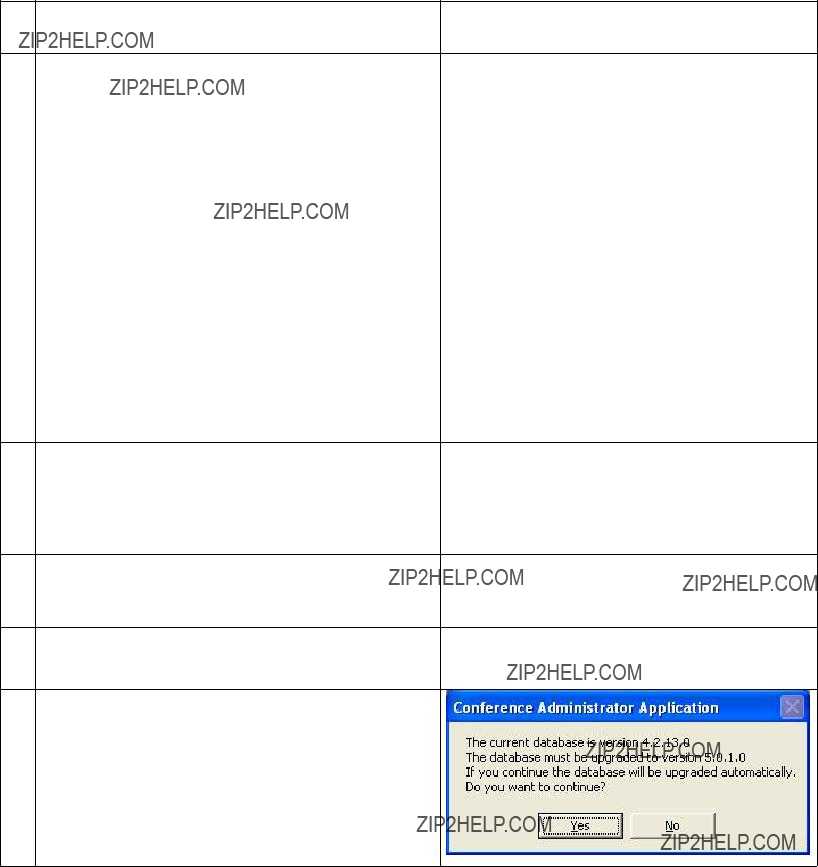
8.3Upgrading procedure, change of database server
If you have a previous SW 6000 version already installed using the SQL 2005 Server
Express and want to use the SQL 2008 Server Express, you can upgrade as follows.
8.3.1Upgrading from SQL 2005 Server Express to SQL 2008 Server Express
66.Backup the Database(s) using ???SW 6000 Backup Utility???.
67.
Select the ???Advanced Installation???.
Select ???Remove All??? to remove the database Accept to delete all SW6000 databases
Enter ???sa??? in the Name field and
Cancel the remaining installation and Finish.
Optionally, it is possible to remove the database using SQL Server Management Studio Express. The use of SQL Server Management Studio Express is not supported by DIS.
68.Remove the old installation using ???Control Panel - Add or Remove Programs??? in the following order:
1.SW6000
2.SQL 2005 Server Express
69.Install the applications as explained in the section ???4.1 ???One PC??? Installation or first installation in a
70.Restore the Database using ???SW 6000 Backup Utility???.
71.Start the CAA.
You will be prompted to upgrade the database when the CAA is started the first time after the installation. Accept this and the database will automatically be upgraded.
Click ???Yes???.

72.The upgrade is now completed. Click ???OK???
73.Update other PCs in the system however do not install the SQL Server 2008 Express on other PC???s.

9
Normally you will not need to
9.1
The SW 6000 Applications can be
The name of the installation is ???SW6000???.
74.To
All the applications are then removed, except the SW 6000 Database and SQL Database Server.
9.2
When the databases (SW
removed, when removing the SW 6000 Application using ???Add or Remove programs???.
The Databases are removed in the following way.
75.Run the SW 6000 Setup program and select ???Advanced Installation???.
Click ???Remove All???

76.You will be asked to enter Database Administrator credentials.
Enter ???sa??? in the Name field and
Click ???Next???
The SW 6000 Database is now removed.
Important: Remember to make backup of the databases. When the databases are removed all conference data is lost.
9.2.1Problems
If the SW 6000 Applications have been removed before the SW 6000 databases are removed or the above procedure for removing the SW 6000 Databases fails the databases can be removed in the following way:
Delete the folder C:\Program
Files\DIS\SW6000 Database
After deleting the database the SQL 2008 server has to be
Important: Remember to make backup of the databases before deleting them. When the databases are removed all conference data is lost.
9.2.2

10 Descriptions of the more technical parts
10.1Database
To use the SW 6000 applications you need a database. The database contains all data used by the application such as delegate names, microphone information etc. etc.
When installing the SW 6000 software a database will be created with initial data.
The ???SQL Database Engine??? hosts all databases.
These SQL servers can host the database for SW 6000:
Microsoft SQL 2000 server, Enterprise Edition or Standard Edition
Microsoft SQL Server 2005 Express
Microsoft SQL Server 2005
Microsoft SQL Server 2008 Express
Microsoft SQL Server 2008
If you are planning to use ???Microsoft SQL Server 2008??? it must be preinstalled on the computer before you install SW 6000. If you are planning to use ???Microsoft SQL Server 2008 Express??? you can use the
???Microsoft SQL Server 2008??? is not part of the SW 6000 software package.
The data in the database is not secured in any way. If you want to secure your data, you must contact your database administrator and change the connect strings used by the applications accordingly. For a description of connects strings see Connect string.
10.2.1Connect string for the SQL Server
For the SQL server the value of the connect string will typically have a value similar to the following: -
Provider = SQLOLEDB.1;Initial
Source=SQLSERVERCOMPUTER;uid=sa;
The ???Provider??? determines how the application should access the database. In this case OLEDB is used ??? which is installed when installing MDAC 2.6.
The ???Initial Catalog??? is the name of the database to connect to; this will most likely be
The ???Data Source??? will be the name of the computer on which the SQL server is running.
The ???uid??? is the user id to be used by the application when connecting to the database. This will most likely be the default system administrator name ???sa??? but it depends on how the SQL Server is installed. If you add security to the SQL Server you might change this to more appropriate value, and for example add a password to the Connect string. If you do please note that this password will be public to anyone with access to the registry on the client- machines.
10.2Connect string
When the applications are connecting to the databases to get access to data they use a ???connect string???. This connect string identifies which database should be used by the application and how.
For the SW 6000 the connect string is located in registry key:
HKEY_LOCAL_MACHINE\SOFTWARE\DIS\DCS 6000\Database\Connect string
